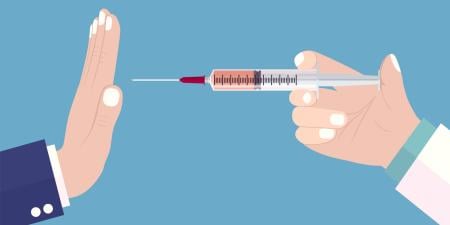The development of the human papillomavirus (HPV) vaccine provides an opportunity to prevent the majority of HPV infections that cause genital warts and cervical cancer. Although the vaccine is largely recognized as a medical breakthrough, its acceptance by the public is lagging for several reasons. Contributing factors include underestimation of HPV risk, the challenge of completing a three-shot regimen, concerns about cost, and parental barriers to acceptance. There is also some public concern about vaccine safety in general, although HPV vaccines have excellent safety records. Attempts to publicize the vaccine’s safety have been undermined by recent erroneous claims linking the vaccine to mental retardation by political figure Michele Bachmann. These inflammatory and irresponsible remarks mislead the public about the safety and efficacy of the vaccine. We examine the facts concerning the HPV vaccine, its utility, and appropriate responses medical professionals can make to false claims.
Introduction
Among the most recent controversial vaccines are those developed to target HPV, a large category of at least 120 double-stranded DNA viruses. HPV is primarily known for causing Condyloma acuminata (genital warts) and is the most common sexually transmitted infection in the Unites States and worldwide [1, 2] The prevalence of genital HPV infection is more than 10 percent among 15-49-year-olds in the United States [3]; however, most infections are cleared within 1 year [4, 5]. Although clearance yields natural immunity, individuals remain susceptible to other strains, and more than 40 of the 120 catalogued HPV types are implicated in the development of genital warts [6]. Approximately 90 percent of genital warts infections are caused by HPV types 6 and 11 [6-8].
More than 20 HPV types cause genital warts and also cause cervical intraepithelial neoplasia, a condition of abnormal growth that can progress to cervical cancer [9]. These high-oncogenic-risk types cause virtually all cervical cancers and most anal cancers [10], and some vulvar [11, 12], vaginal [13], and head and neck cancers [14]. Compared to the clearance rates of types 6 and 11, the oncogenic HPV types show delayed clearance [15-18], and together, oncogenic types 16 and 18 account for more than 70 percent of cervical cancers [19, 20]. Given the role of types 6 and 11 in genital warts and types 16 and 18 in cervical cancer, vaccination against these specific HPV types has been recommended [21] and in a few instances mandated [22].
Vaccine Safety
Cervical cancer ranks as the second most common cancer and the fifth leading cause of death of women worldwide [23]. In response to this serious health issue, more than 20 years of incremental research culminated in the development of HPV vaccines that elicit strong immunogenic reactions without the risk of causing infection [24-26]. Researchers achieved this through the recombinant expression of an HPV capsid protein that spontaneously self-assembles into virus-like particles [27]. These particles form into capsomeres that resemble HPV virions [28] but lack viral DNA; the capsomeres are combined with an adjuvant to elicit robust antibody responses, creating long-term immunity [27, 29, 30].
Vaccines are administered via three intramuscular injections spaced over 6 months. Results of several clinical trials show that vaccinated women remain free of HPV types targeted by the vaccine through the entire duration of the trial [25, 31, 32]. Importantly, the vaccine affords a high degree of protection against HPV infection that extends to protection from associated cervical lesions [33]. Ongoing studies are assessing the duration of protection.
Based on these findings, the FDA approved Gardasil, a quadrivalent vaccine against HPV types 6, 11, 16, and 18 licensed by Merck, in 2006 and Cervarix, a bivalent vaccine for types 16 and 18 made by GlaxoSmithKline, in 2009. Both have been approved and are in use in many nations [34, 35] In fact, the FDA reports that more than 65 million doses of Gardasil have been distributed worldwide [36].
Both HPV vaccines have strong safety records. The most commonly reported adverse events are pain and swelling at injection site [37, 38]. There has been no evidence that Gardasil or Cervarix administration increases rates of death, blood clots, or cognitive impairment. Even though these vaccines continue to generate excellent safety records, low coverage rates in the United States still leave many susceptible to the threat of cervical cancer and genital warts [39].
Maximizing Vaccine Efficacy
HPV vaccination only protects against HPV types to which the individual has never been exposed. Routes of exposure include skin-to-skin and sexual contact [40-42]. It follows that vaccination efficacy is maximized in individuals who are not yet sexually active and thus likely to be HPV-negative. Indeed, clinical studies fail to demonstrate any benefit to women previously exposed to HPV types covered by the vaccine [31, 43]. Acknowledging these facts, the FDA approved Gardasil and Cervarix for females aged 9-26 and 10-25, respectively, and the general consensus among health organizations in the United States and worldwide is for vaccination of girls aged 11-12 [21, 41-47].
Although most research addresses the vaccination impact on female health outcomes, optimizing HPV vaccine efficacy also requires immunizing males. The value of including both sexes in HPV vaccination programs is indirect, in reducing transmission rates to females [48], and direct through the individual protective effects afforded by HPV vaccination. Males deserve access to a vaccine that can prevent the majority of cases of genital warts, especially considering that males often suffer longer duration of genital warts and incur greater treatment costs than females [49]. Furthermore, HPV is responsible for a wide range of cancers including 70-100 percent of penile intraepithelial neoplasia and 40-50 percent of all invasive penile cancers [50]. In recognition of these factors, the FDA approved Gardasil for the prevention of genital warts [51], anal cancer, and associated precancerous lesions in males in 2010 [36], The prophylactic prevention of HPV infection is clearly warranted regardless of sex, and the vaccination of males is regarded as a cost-effective approach to reduce rates of HPV infection [52].
Finally, research indicates that nonsexual modes of HPV transmission include perinatal transmission from an infected mother [53]. Vertical transmission of the virus occurs primarily during vaginal delivery [54], but HPV can also infect infants delivered by caesarean section [55] and can be transmitted transplacentally to the fetus [56]. Newborns who acquire genital HPV infection may incur higher risks for genital dysplasia and cancer in addition to genital warts. The virus is just as likely to infect the oral mucosa of the newborn as the genitals [57], posing an additional risk of respiratory tract papillomas, which are the most common benign tumors of the larynx in infants and children [58]. Given the diverse manifestations of HPV infection, widespread vaccination coverage holds the potential to benefit a broad range of people.
Sexual Politics and Corporate Suspicions
Although the medical and scientific establishment has embraced the vaccine [59], HPV vaccination rates are inadequate in the United States [39]. Vaccine coverage is hindered by public perceptions regarding HPV’s status as a sexually transmitted infection and dissent over the recommended age of vaccination [60]. Social conservatives have countered vaccine mandates with the argument that they infringe upon parental rights to discuss the topic of sex on their own terms [61]. Pro-abstinence activists raise similar concerns that HPV vaccination may increase teenage promiscuity [62], though there is no evidence for this claim [63]. Another suspicion is that HPV vaccine manufacturers have obtained FDA approval through corporate influence in lieu of proper safety testing [64-66]. Finally, several studies have shown that parents fail to vaccinate due to misperceptions about the risk of HPV infection [47].
Inflammatory False Claims
On September 12th, 2011, controversy over the HPV vaccine was reignited by the remarks of Republican presidential candidate Michele Bachmann during a debate. After denouncing an opponent’s role in mandating HPV vaccination in Texas, Bachmann made unsubstantiated claims that the HPV vaccine was hazardous. During an interview with Fox News she told this anecdote:
There’s a woman who came up crying to me tonight after the debate. She said her daughter was given that vaccine. She told me her daughter suffered mental retardation as a result of that vaccine. There are very dangerous consequences [67].
Bachmann repeated this dramatic encounter during an interview on NBC’s Today show [68]. These remarks were met with outrage by members of the scientific community, with multiple health and medical organizations denouncing their validity within days [69-71]. In jockeying for political gain, Bachmann disseminated false information to the detriment of public health. She made no attempt to apologize for her remarks or correct them. In fact, she reasserted her claims about the danger of the vaccine as recently as November 2011 [72]. As a public figure with access to an enormous audience, her promoting misconceptions that lead to higher risk for women, men, and babies is inexcusable.
Such events are likely to increase public distrust of vaccines and confusion, but the ultimate repercussions of Bachmann’s charged rhetoric are not yet clear. Although few would argue that spreading blatant misinformation should be a punishable offense, false claims about vaccine risk can have deadly consequences when they discourage vaccination [73, 74], so they should not be ignored. To counter the effects of invalid statements, the public health sector must work even harder to educate the public in order to reach vaccination coverage. Whatever one’s views on mandates or the cost of the vaccine, its excellent safety record and capacity to benefit human health make protecting the reputation of the HPV vaccine from damaging false claims worthwhile.
Studies show that the influence of accurate information about vaccines is maximized when conveyed from physician to parent or patient [75]. In prioritizing this approach over general health advertisement campaigns, physicians retain their position as patient advocates rather than agents of the government who must enforce policy. Research suggests that physicians are the most influential source of information about vaccines, including the HPV vaccine [76-78], for parents [79, 80]. In fact, some research shows that physicians’ attitudes have a larger impact on immunization rates than the media coverage [81]. Ultimately, the decision to vaccinate a child must be based on an informative discussion between a parent and a physician, not on the erroneous claims of political candidates. When public figures imperil the safety of the public with irresponsible claims and fear mongering, it is imperative that both organized medicine and individual physicians speak up.
References
-
Aral SO, Holmes KK. The epidemiology of STIs and their social and behavioral determinants: industrialized and developing countries. Holmes KK, ed. Sexually Transmitted Diseases. 3rd ed. New York: McGraw-Hill; 1999: 53-92.
- Weinstock H, Berman S, Cates W Jr. Sexually transmitted diseases among American youth: incidence and prevalence estimates, 2000. Perspect Sex Reprod Health. 2004;36(1):6-10.
-
Koutsky LA, Galloway DA, Holmes KK. Epidemiology of genital human papillomavirus infection. Epidemiol Rev. 1988;10:122-163.
- Ho GY, Bierman R, Beardsley L, Chang CJ, Burk RD. Natural history of cervicovaginal papillomavirus infection in young women. N Engl J Med. 1998;338(7):423-428.
- Moscicki AB, Hills N, Shiboski S, et al. Risks for incident human papillomavirus infection and low-grade squamous intraepithelial lesion development in young females. JAMA. 2001;285(23):2995-3002.
- Chow LT, Nasseri M, Wolinsky SM, Broker TR. Human papillomavirus types 6 and 11 mRNAs from genital condylomata acuminata. J Virol. 1987;61(8):2581-2588.
- de Villiers EM, Gunst K, Stein H, Scherubl H. Esophageal squamous cell cancer in patients with head and neck cancer: prevalence of human papillomavirus DNA sequences. Int J Cancer. 2004;109(2):253-258.
- zur Hausen H. Papillomaviruses causing cancer: evasion from host-cell control in early events in carcinogenesis. J Natl Cancer Inst. 2000;92(9):690-698.
- Walboomers JM, Jacobs MV, Manos MM, et al. Human papillomavirus is a necessary cause of invasive cervical cancer worldwide. J Pathol. 1999;189(1):12-19.
- Palefsky JM, Holly EA, Gonzales J, Berline J, Ahn DK, Greenspan JS. Detection of human papillomavirus DNA in anal intraepithelial neoplasia and anal cancer. Cancer Res. 1991;51(3):1014-1019.
- van Beurden M, ten Kate FJ, Smits HL, et al. Multifocal vulvar intraepithelial neoplasia grade III and multicentric lower genital tract neoplasia is associated with transcriptionally active human papillomavirus. Cancer. 1995;75(12):2879-2884.
- Buscema J, Naghashfar Z, Sawada E, Daniel R, Woodruff JD, Shah K. The predominance of human papillomavirus type 16 in vulvar neoplasia. Obstet Gynecol. 1988;71(4):601-606.
- Srodon M, Stoler MH, Baber GB, Kurman RJ. The distribution of low and high-risk HPV types in vulvar and vaginal intraepithelial neoplasia (VIN and VaIN). Am J Surg Pathol. 2006;30(12):1513-1518.
- Brachman DG, Graves D, Vokes E, et al. Occurrence of p53 gene deletions and human papilloma virus infection in human head and neck cancer. Cancer Res. 1992;52(17):4832-4836.
- Franco EL, Villa LL, Sobrinho JP, et al. Epidemiology of acquisition and clearance of cervical human papillomavirus infection in women from a high-risk area for cervical cancer. J Infect Dis. 1999;180(5):1415-1423.
- Giuliano AR, Harris R, Sedjo RL, et al. Incidence, prevalence, and clearance of type-specific human papillomavirus infections: The Young Women’s Health Study. J Infect Dis. 2002;186(4):462-469.
- Richardson H, Kelsall G, Tellier P, et al. The natural history of type-specific human papillomavirus infections in female university students. Cancer Epidemiol Biomarkers Prev. 2003;12(6):485-490.
- Munoz N, Mendez F, Posso H, et al. Incidence, duration, and determinants of cervical human papillomavirus infection in a cohort of Colombian women with normal cytological results. J Infect Dis. 2004;190(12):2077-2087.
- Schiffman M, Castle PE, Jeronimo J, Rodriguez AC, Wacholder S. Human papillomavirus and cervical cancer. Lancet. 2007;370(9590):890-907.
- Munoz N, Bosch FX, Castellsague X, et al. Against which human papillomavirus types shall we vaccinate and screen? The international perspective. Int J Cancer. 2004;111(2):278-285.
-
Markowitz LE, Dunne EF, Saraiya M, et al. Quadrivalent human papillomavirus vaccine: recommendations of the Advisory Committee on Immunization Practices (ACIP). MMWR Recomm Rep. 2007;56(RR-2):1-24. http://www.cdc.gov/mmwr/preview/mmwrhtml/rr5602a1.htm?s_cid=rr5602a1_e. Accessed September 16, 2011.
-
National Conference of State Legislatures. HPV vaccine; 2011. http://www.ncsl.org/IssuesResearch/Health/HPVVaccineStateLegislation/tabid/14381/Default.aspx#hpvlegis. Accessed October 10, 2011.
- Bosch FX, Manos MM, Munoz N, et al. Prevalence of human papillomavirus in cervical cancer: a worldwide perspective. International biological study on cervical cancer (IBSCC) Study Group. J Natl Cancer Inst. 1995;87(11):796-802.
- Emeny RT, Wheeler CM, Jansen KU, et al. Priming of human papillomavirus type 11-specific humoral and cellular immune responses in college-aged women with a virus-like particle vaccine. J Virol. 2002;76(15):7832-7842.
- Brown DR, Fife KH, Wheeler CM, et al. Early assessment of the efficacy of a human papillomavirus type 16 L1 virus-like particle vaccine. Vaccine. 2004;22(21-22):2936-2942.
- Fife KH, Wheeler CM, Koutsky LA, et al. Dose-ranging studies of the safety and immunogenicity of human papillomavirus Type 11 and Type 16 virus-like particle candidate vaccines in young healthy women. Vaccine. 2004;22(21-22):2943-2952.
- Kirnbauer R, Booy F, Cheng N, Lowy DR, Schiller JT. Papillomavirus L1 major capsid protein self-assembles into virus-like particles that are highly immunogenic. Proc Natl Acad Sci U S A. 1992;89(24):12180-12184.
- Zhou J, Sun XY, Stenzel DJ, Frazer IH. Expression of vaccinia recombinant HPV 16 L1 and L2 ORF proteins in epithelial cells is sufficient for assembly of HPV virion-like particles. Virology. 1991;185(1):251-257.
- Ghim SJ, Jenson AB, Schlegel R. HPV-1 L1 protein expressed in cos cells displays conformational epitopes found on intact virions. Virology. 1992;190(1):548-552.
- Rose RC, Bonnez W, Reichman RC, Garcea RL. Expression of human papillomavirus type 11 L1 protein in insect cells: in vivo and in vitro assembly of viruslike particles. J Virol. 1993;67(4):1936-1944.
- Koutsky LA, Ault KA, Wheeler CM, et al. A controlled trial of a human papillomavirus type 16 vaccine. N Engl J Med. 2002;347(21):1645-1651.
- Harper DM, Franco EL, Wheeler C, et al. Efficacy of a bivalent L1 virus-like particle vaccine in prevention of infection with human papillomavirus types 16 and 18 in young women: a randomised controlled trial. Lancet. 2004;364(9447):1757-1765.
- Harper DM, Franco EL, Wheeler CM, et al. Sustained efficacy up to 4.5 years of a bivalent L1 virus-like particle vaccine against human papillomavirus types 16 and 18: follow-up from a randomised control trial. Lancet. 2006;367(9518):1247-1255.
-
Department of Health and Aging, Australian Government. Human papillomavirus (hpv); information about the national HPV Vaccination program funded under the Immunise Australia Program; 2011. http://health.gov.au/internet/immunise/publishing.nsf/Content/immunise-hpv. Accessed December 16, 2011.
-
Joint Committee on Vaccination and Immunisation (JCVI). Statement on human papillomavirus vaccines to protect against cervical cancer; 2008. http://www.parliament.uk/deposits/depositedpapers/2011/DEP2011-0706.pdf. Accessed September 13, 2011
-
Gardasil approved to prevent anal cancer [news release]. Silver Spring, MD: US Food and Drug Administration; December 22, 2010. http://www.fda.gov/NewsEvents/Newsroom/PressAnnouncements/2010/ucm237941.htm. Accessed September 9, 2011
- Einstein MH, Baron M, Levin MJ, et al. Comparison of the immunogenicity and safety of Cervarix and Gardasil human papillomavirus (HPV) cervical cancer vaccines in healthy women aged 18-45 years. Hum Vaccin. 2009;5(10):705-719.
-
Centers for Disease Control and Prevention. Reports of health concerns following HPV vaccination. http://www.cdc.gov/vaccinesafety/vaccines/hpv/gardasil.html. Accessed October 7, 2011.
-
Centers for Disease Control and Prevention. National and state vaccination coverage among adolescents aged 13 through 17 years --- United States, 2010. MMWR Morb Mortal Wkly Rep. 2011;60(33):1117-1123. http://www.cdc.gov/mmwr/preview/mmwrhtml/mm6033a1.htm. Accessed October 1, 2011.
- Mindel A, Tideman R. HPV transmission--still feeling the way. Lancet. 1999;354(9196):2097-2098.
- Sonnex C, Strauss S, Gray JJ. Detection of human papillomavirus DNA on the fingers of patients with genital warts. Sex Transm Infect. 1999;75(5):317-319.
- Winer RL, Lee SK, Hughes JP, Adam DE, Kiviat NB, Koutsky LA. Genital human papillomavirus infection: incidence and risk factors in a cohort of female university students. Am J Epidemiol. 2003;157(3):218-226.
- Hildesheim A, Herrero R, Wacholder S, et al. Effect of human papillomavirus 16/18 L1 viruslike particle vaccine among young women with preexisting infection: a randomized trial. JAMA. 2007;298(7):743-753.
- Harper DM, Paavonen J. Age for HPV vaccination. Vaccine. 2008;26(Suppl 1):A7-A11.
-
Centers for Disease Control and Prevention (CDC). FDA licensure of bivalent human papillomavirus vaccine (HPV2, Cervarix) for use in females and updated HPV vaccination recommendations from the Advisory Committee on Immunization Practices (ACIP). MMWR Morb Mortal Wkly Rep. 2010;59(20):626-629. http://www.cdc.gov/mmwr/preview/mmwrhtml/mm5920a4.htm?s_cid=mm5920a4_e. Accessed September 20, 2011.
-
American Congress of Obstetricians and Gynecologists. Ob Gyns Recommend HPV Vaccination for Young Girls. http://www.acog.org/About_ACOG/News_Room/News_Releases/2010/Ob_Gyns_Recommend_HPV_Vaccination_for_Young_Girls.aspx. Accessed December 16, 2011.
- Wright TC Jr, Huh WK, Monk BJ, Smith JS, Ault K, Herzog TJ. Age considerations when vaccinating against HPV. Gynecol Oncol. 2008;109(2 Suppl):S40-S47.
- Zunzunegui MV, King MC, Coria CF, Charlet J. Male influences on cervical cancer risk. Am J Epidemiol. 1986;123(2):302-307.
- Giuliano AR. Human papillomavirus vaccination in males. Gynecol Oncol. 2007;107(2 Suppl 1):S24-S26.
-
Dillner J, von Krogh G, Horenblas S, Meijer CJ. Etiology of squamous cell carcinoma of the penis. Scand J Urol Nephrol Suppl. 2000;(205):189-193.
-
FDA approves new indication for gardasil to prevent genital warts in men and boys [news release]. Silver Spring, MD: US Food and Drug Administration; October 16, 2009. http://www.fda.gov/NewsEvents/Newsroom/PressAnnouncements/ucm187003.htm. Accessed December 15, 2011.
- Elbasha EH, Dasbach EJ, Insinga RP. Model for assessing human papillomavirus vaccination strategies. Emerg Infect Dis. 2007;13(1):28-41.
- Quick CA, Watts SL, Krzyzek RA, Faras AJ. Relationship between condylomata and laryngeal papillomata. Clinical and molecular virological evidence. Ann Otol Rhinol Laryngol. 1980;89(5 Pt 1):467-471.
- Puranen MH, Yliskoski MH, Saarikoski SV, Syrjanen KJ, Syrjanen SM. Exposure of an infant to cervical human papillomavirus infection of the mother is common. Am J Obstet Gynecol. 1997;176(5):1039-1045.
- Favre M, Majewski S, De Jesus N, Malejczyk M, Orth G, Jablonska S. A possible vertical transmission of human papillomavirus genotypes associated with epidermodysplasia verruciformis. J Invest Dermatol. 1998;111(2):333-336.
-
Rombaldi RL, Serafini EP, Mandelli J, Zimmermann E, Losquiavo KP. Transplacental transmission of human papillomavirus. Virol J. 2008;5:106.
-
Smith EM, Parker MA, Rubenstein LM, Haugen TH, Hamsikova E, Turek LP. Evidence for vertical transmission of HPV from mothers to infants. Infect Dis Obstet Gynecol. 2010;2010:326369.
-
Mounts P, Shah KV. Respiratory papillomatosis: etiological relation to genital tract papillomaviruses. Prog Med Virol. 1984;29:90-114.
-
Neiderhuber JE. Taking pride in an important achievement. National Cancer Institute Bulletin. 2006;3(24). http://www.cancer.gov/aboutnci/ncicancerbulletin/archive/2006/061306/page3. October 11, 2011.
- Mays RM, Sturm LA, Zimet GD. Parental perspectives on vaccinating children against sexually transmitted infections. Soc Sci Med. 2004;58(7):1405-1413.
-
Focus on the Family. Position statement: human papillomavirus vaccines; 2007. http://www.family.org/sharedassets/correspondence/pdfs/PublicPolicy/Position_Statement-Human_Papillomavirus_Vaccine.pdf. Accessed September 22, 2011.
-
Parker S. The perverse politics of Gardasil. Center for Urban Renewal and Education. http://www.urbancure.org/article.asp?id=3026&tag=. Accessed October 18, 2011.
- Lo B. HPV vaccine and adolescents’ sexual activity. BMJ. 2006;332(7550):1106-1107.
-
Parker S. Vaccine mandate explains mess of health system. Center for Urban Renewal and Education. http://www.urbancure.org/article.asp?id=3027&tag=. Accessed December 16, 2011.
- Dempsey AF, Singer D, Clark SJ, Davis MM. Parents’ views on 3 shot-related visits: implications for use of adolescent vaccines like human papillomavirus vaccine. Acad Pediatr. 2009;9(5):348-352.
- Davis K, Dickman ED, Ferris D, Dias JK. Human papillomavirus vaccine acceptability among parents of 10- to 15-year-old adolescents. J Low Genit Tract Dis. 2004;8(3):188-194.
-
Michele Bachmann says HPV vaccine can cause mental retardation. PolitiFact. September 13, 2011. http://www.politifact.com/truth-o-meter/statements/2011/sep/16/michele-bachmann/bachmann-hpv-vaccine-cause-mental-retardation/. Accessed October 11, 2011.
-
Bachmann: Perry’s HPV vaccine order immoral [video]. Today. http://today.msnbc.msn.com/id/26184891/vp/44499076#44499076. Accessed October 11, 2011.
-
Smith B. Bachmann’s vaccine doubts ‘dangerous and irresponsible’. Politico. September 13, 2011. http://www.politico.com/blogs/bensmith/0911/Bachmanns_vaccine_doubts_dangerous_and_irresponsible.html. Accessed October 10, 2011.
-
Burton OM. American Academy of Pediatrics statement on HPV vaccine. Elk Grove Village, IL: American Academy of Pediatrics; September 13, 2011. http://www.aap.org/advocacy/releases/hpv2011.pdf. Accessed September 18, 2011.
-
Morrissey E. Bachmann: Gardasil causes “mental retardation”. Hot Air. September 13, 2011. http://hotair.com/archives/2011/09/13/bachmann-gardasil-causes-mental-retardation/. Accessed October 19, 2011.
-
Hafner J. To one Iowa mother, Bachmann decries ‘the ravages’ of HPV vaccine. Des Moines Register. November 14, 2011. http://caucuses.desmoinesregister.com/2011/11/14/to-one-iowa-mother-bachmann-decries-the-ravages-of-hpv-vaccine/. Accessed November 15, 2011.
-
Deer B. Schoolboy, 13, dies as measles makes a comeback. April 2, 2006. http://briandeer.com/wakefield/measles-death.htm. Accessed October 19, 2011.
-
Dobson R. Media misled the public over the MMR vaccine, study says. BMJ. 2003;326(7399):1107.
- Dempsey AF, Abraham LM, Dalton V, Ruffin M. Understanding the reasons why mothers do or do not have their adolescent daughters vaccinated against human papillomavirus. Ann Epidemiol. 2009;19(8):531-538.
- Dempsey AF, Zimet GD, Davis RL, Koutsky L. Factors that are associated with parental acceptance of human papillomavirus vaccines: a randomized intervention study of written information about HPV. Pediatrics. 2006;117(5):1486-1493.
- Brewer NT, Fazekas KI. Predictors of HPV vaccine acceptability: a theory-informed, systematic review. Prev Med. 2007;45(2-3):107-114.
- Zimet GD, Mays RM, Winston Y, Kee R, Dickes J, Su L. Acceptability of human papillomavirus immunization. J Womens Health Gend Based Med. 2000;9(1):47-50.
- Fredrickson DD, Davis TC, Arnould CL, et al. Childhood immunization refusal: provider and parent perceptions. Fam Med. 2004;36(6):431-439.
- Gellin BG, Maibach EW, Marcuse EK. Do parents understand immunizations? A national telephone survey. Pediatrics. 2000;106(5):1097-1102.
- Smith MJ, Ellenberg SS, Bell LM, Rubin DM. Media coverage of the measles-mumps-rubella vaccine and autism controversy and its relationship to MMR immunization rates in the United States. Pediatrics. 2008;121(4):e836-e843.



